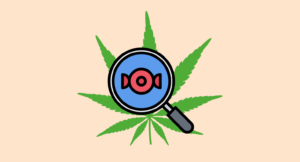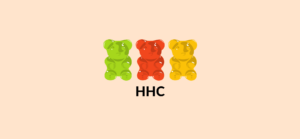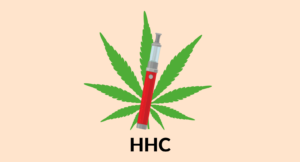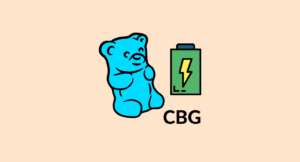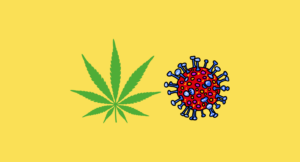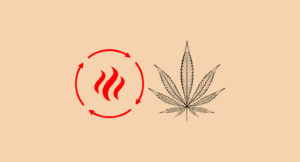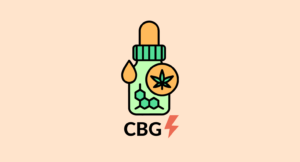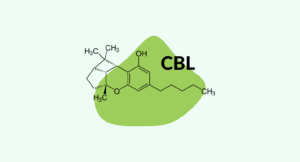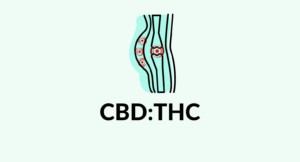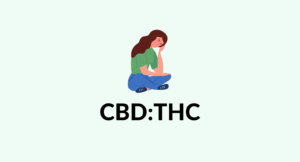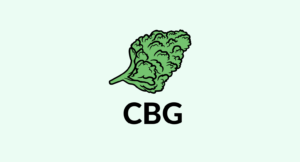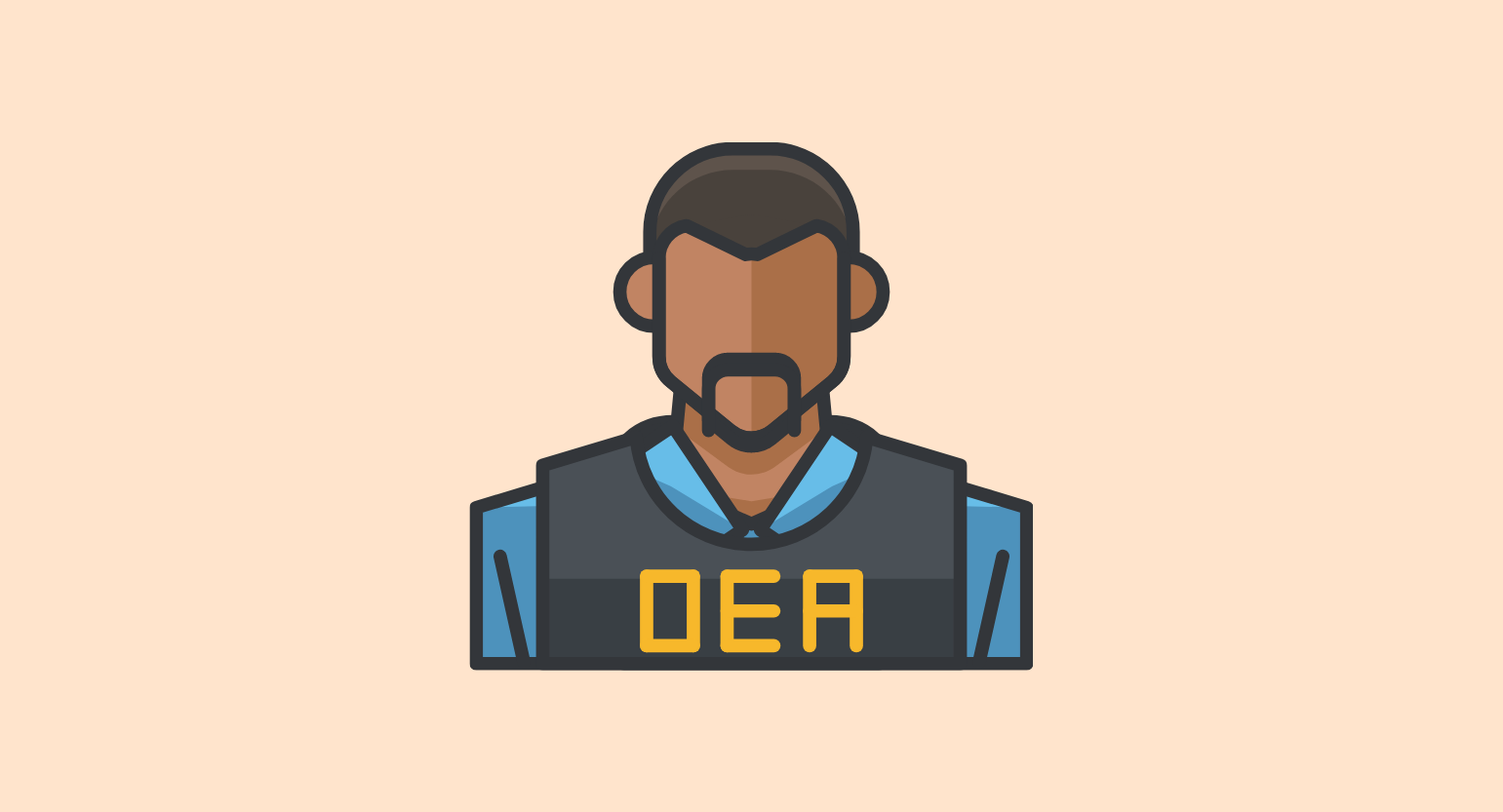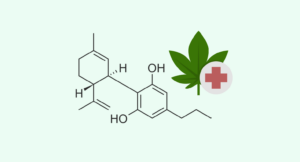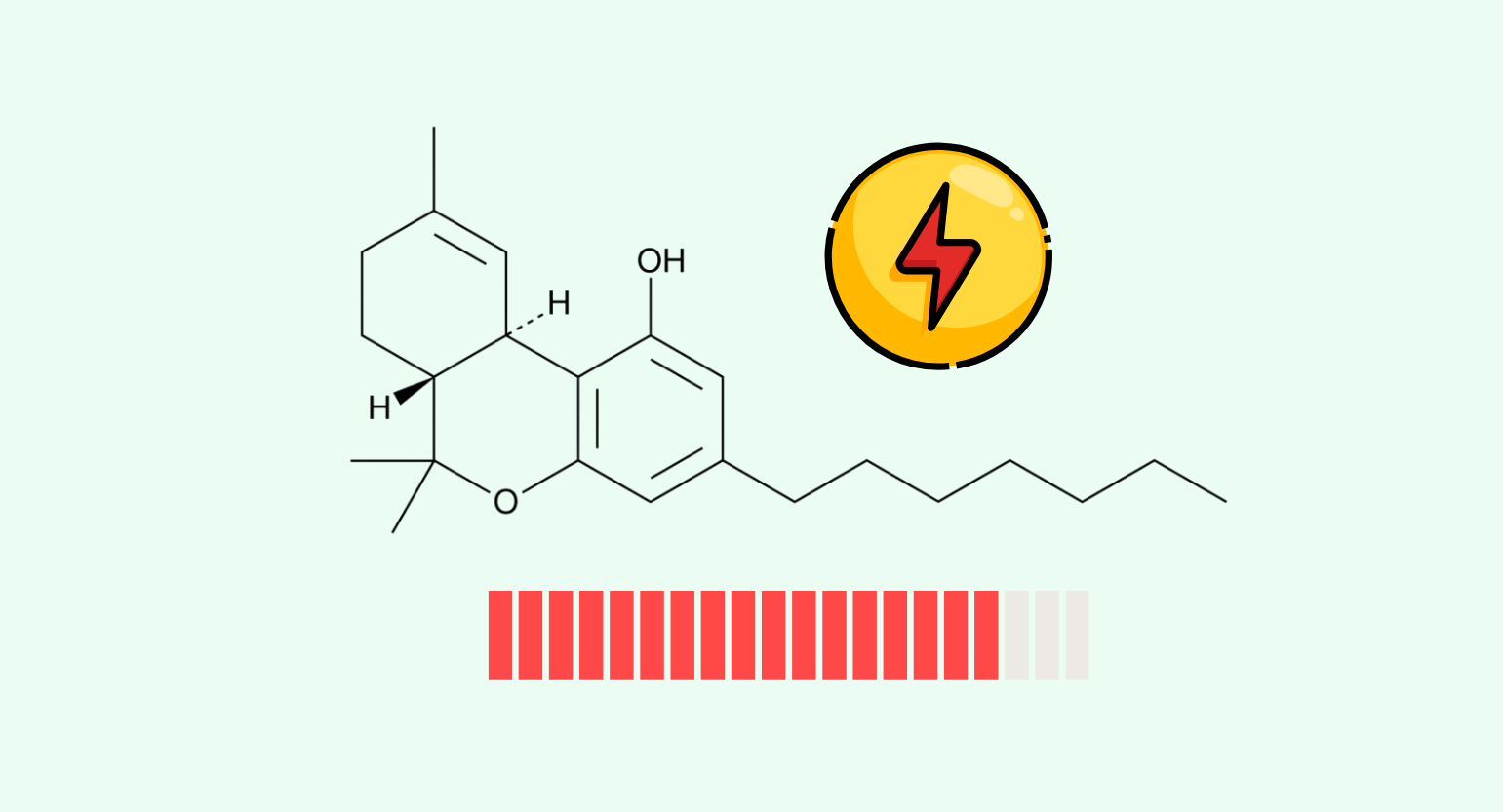
Evidence based
What is THCP? 33X Stronger Than THC?
THCP is reported to be more than 30x more potent than THC.
Here’s what you should know before you buy.
There’s no shortage of new THC analogs these days. Recently we’ve seen a surge in public interest for THC alternatives like delta 8 THC and delta 10 THC.
More recently, a synthetic form of THC called THC-O has started to flood into the market — heralded as a more potent form of THC.
Today, we’d like to introduce another, even more powerful THC alternative called THCP. This cannabinoid is thought to be up to 33 times more potent than conventional THC.
So what is THCP? Is it safe? Is it natural?
Here’s everything you need to know before you buy.
In A Nutshell: What is THCP?
THCP (Δ9-Tetrahydrocannabiphorol) is a newly discovered, naturally-occurring analog of THC.
The only difference between THCP from “regular” THC is the presence of 2 extra carbons in its chemical structure. Instead of 5 carbons on its alkyl side chain like THC, THCP has 7. This subtle difference is enough to make THCP substantially stronger than conventional THC.
While this cannabinoid was only discovered in 2019, it’s believed to have been around for a long time unnoticed. Some researchers, such as Dr. Giuseppe Cannazza, believe THCP could be the reason why some strains of marijuana are so much more psychoactive than others despite having the same or lower THC concentrations.
THCP was first discovered by accident when a team of Italian researchers funded by the UNIHEMP research project. The researchers were examining the chemical profile of a strain called FM2.
Using high-performance mass spectrometry and other precision testing equipment, the team noticed some strange findings. Their report was published in December 2019 — which highlighted both THCP and CBDP [1].
CBDP appears to have virtually no interaction with the endocannabinoid system, so there’s been little interest to study it further. THCP, however, has been reported to have more than 30 times the binding affinity compared to THC. Most people who have used THCP place the potency closer to 5 or 10 times more potent than THC, but the true potency of this cannabinoid is still hotly debated.
Key Points: What is THCP?
- THCP occurs naturally in marijuana in trace amounts
- THCP is roughly 5–10 times more potent than THC (some reports suggest it to be 33 times more potent)
- THCP may be the reason some strains are so much stronger than others, regardless of total THC concentration
- THCP may be legal in the United States
- There are delta 7, delta 8, delta 9, and delta 10 versions of THCP
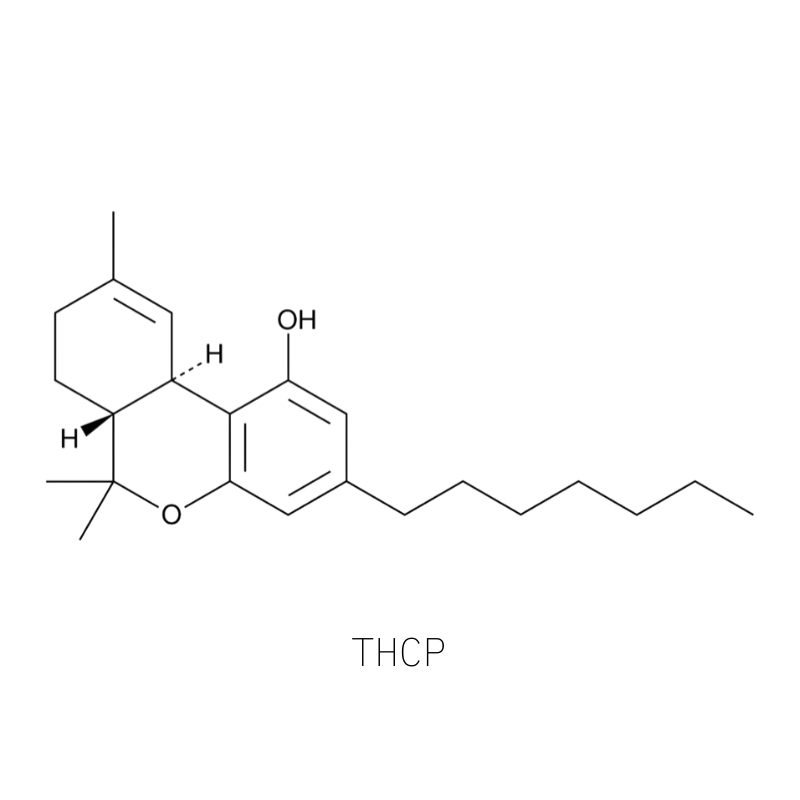
How Strong is THCP?
The main selling point of THCP is its aggressive psychoactivity. This cannabinoid is reported to be as much as 33 times stronger than delta 9 THC.
But this isn’t exactly true.
In vitro studies have shown that THCP has roughly 33 times the binding affinity for the CB1 receptors compared to delta 9 THC — but this doesn’t mean its effects are 33 times stronger.
Most people who have tried THCP (there aren’t very many) report the effects are somewhere between 5 and 10 times the potency of delta 9 THC (which is still a substantial increase in potency).
What Makes THCP So Psychoactive?
The molecular structure of THCP is nearly identical to THC. The only difference is that instead of having a 5 carbon alkyl chain, THCP has a 7-carbon chain.
In the past, researchers have demonstrated that in order for THC to have any psychoactive effects at all, there need to be at least 3 carbons on this chain. The more carbons, the stronger the effect (there are limitations to this).
For example, THCC has one carbon and is entirely non-psychoactive. THCV has three carbons and about 25% the potency of THC.
Delta 8, 9, and 10 THC comes next with 5 carbons each, and THCP at the top with 7 carbons.
Another popular, more potent form of THC is THC-O-acetate. This synthetic cannabinoid owes its higher potency to a higher bioavailability rather than having a stronger binding affinity to CB1 receptors.
This means more is absorbed through the gut and passes across the blood-brain barrier than conventional THC.

How Long Does THCP Take To Kick In?
Edible forms of THCP, such as gummies or tinctures, take about an hour to kick in. The effects continue to increase over the following hour and peak by hour 3. These effects remain in full force for about 2 hours before gradually tapering off. The whole experience lasts between 4 and 6 hours.
Inhaled forms of THCP, such as vapes or THCP flower, kick in much quicker — within about 15 minutes. Peak experience is reached by the 1-hour mark and begins to taper off about 2 hours later. The whole experience from inhaled THCP lasts between 3 and 5 hours.
What’s The Dose of THCP
There are no clearly defined doses for THCP yet. There simply hasn’t been enough research or anecdotal reports from people using this compound to offer any concrete dosages.
With that said, most people who have used this compound place the potency somewhere around 5–10 times higher than delta 9 THC. So we can use this to estimate the optimal dosage range.
Delta 9 THC is active starting around the 5 mg dose. The standard psychoactive dose of D9 THC ranges from 10 to 40 mg.
Therefore, an equivalent dose of THCP maybe somewhere between 1 and 4 mg. Most people start with a dose of 0.3 mg and work their way up from there.
Because of how potent this stuff is, it’s easy to take too much. Just a 1 mg difference in the dose could be enough to push you over the edge. While THCP isn’t inherently dangerous, taking too much can be very uncomfortable — causing users to feel incapacitated, anxious, dizzy, or nauseous.
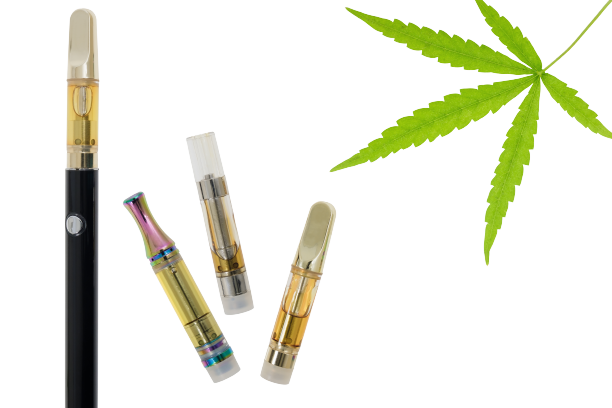
Is THCP Legal?
THCP is not listed by name on any prohibited substances list — but this doesn’t make it legal.
Most countries, including the United States, have laws that automatically place analogs of prohibited substances within the same regulatory class. This means THCP, along with other THC analogs such as THCO and THCC, are likely considered illegal on a federal level.
Many countries in Europe have comparable laws — making THCP most likely illegal in places like Germany, the United Kingdom, France, Italy, Spain, Denmark, and Sweden.
The exception here is Canada, which doesn’t have analog drug laws — which makes THCP legal. However, it’s virtually impossible to find suppliers of THCP in Canada at the moment.
Comparing the Different Kinds of THC
Just 5 years ago, THC only referred to one compound — delta 9 THC — the primary active ingredient in marijuana.
Today, there are more than a dozen types of THC, each one distinct from the others.
Most THC analogs have the same base effect profile — producing feelings of euphoria and altered sensory perception. The differences between each form of THC come down to aspects like potency, qualitative effects, and headspace.
Comparing THCP, THC-O, Δ9 THC, & Δ8 THC
| THCP | THC-O | Delta 9 THC | Delta 8 THC | |
| Natural or Synthetic? | Natural | Synthetic | Natural | Naturally-Derived |
| Average Concentration in Hemp | <0.1% | 0% | <0.3% | <0.1% |
| Average Concentration in Marijuana | <0.1% | 0% | 15–20% | <1% |
| Primary Health Benefit | Unknown | Sleep-Supportive & Analgesic | Analgesic & Anti-Epileptic | Anxiolytic & Sleep-Supportive |
| Primary Target Receptors | CB1 (++) & CB2 | CB1 & CB2 | CB1 & CB2 | CB1 & CB2 |
| Psychoactivity | Very High | Very High | High | Moderate |
| Cost Per Milligram | $0.50–$1.00 | $0.15–$0.20 per mg | $0.07–$0.13 per mg | $0.06–$0.12 per mg |
| Headspace | Heavy | Heavy | Moderate to Heavy | Mild to Moderate |
Comparing the Potency of THC Analogs
THCP is the strongest naturally occurring cannabinoid currently known. It’s most comparable in strength to synthetic forms of THC, such as THC-O.
THCP is roughly 1.5 times stronger than THC-O, 5–10 times stronger than delta 9 THC, 10–20 times stronger than delta 8 and delta 10 THC, and nearly 40 times stronger than THCV.
Potency refers to the intensity of effects for a given dose. There are two ways to assess the potency of THC; we can test the binding affinity of the compound on the target receptors (CB1 and CB2 receptors), and we can compare the qualitative effects of two or more types of THC at the same dose.
Factors that can affect the potency of THC include:
- Bioavailability and absorption
- CB1 and CB2 binding affinity
- Other receptor binding affinity
Ranking psychoactive cannabinoids by potency level:
- THCP (strongest)
- THC-O
- Delta 9 THC
- Delta 8 THC
- Delta 10 THC
- THCV
- CBN (weakest)
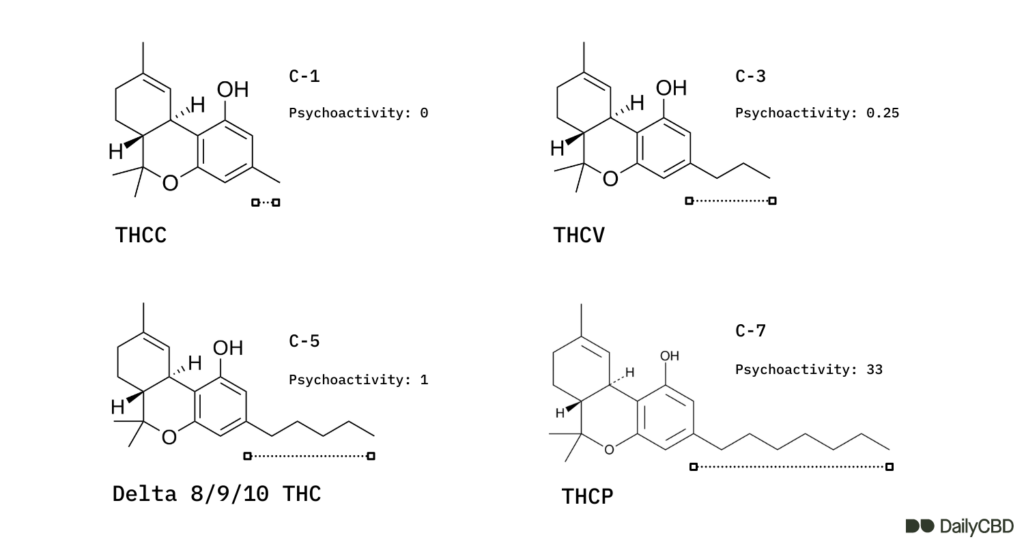
Qualitative Effects: How THCP Feels
The qualitative effects of a substance refer to the way a substance feels.
This information is hard to measure through scientific testing, so most of the qualitative profiles of these substances come from people that have tried the substance for themselves and report their experiences.
There isn’t a lot of information available for the qualitative effects of THCP. However, the few anecdotal reports suggest this cannabinoid shares the same general effects as delta 9 THC, but with more stimulating action and a stronger alteration in visual and auditory perception.
THCP is not hallucinogenic, but the experience is often described as psychedelic-like.
You won’t see things, leave your body, or experience any classical psychedelic effects — but it does push your perception away from the center point. You may find interest in things you normally wouldn’t, music may sound different than you remember, and colors may appear amplified.
The side effects are also amplified.
People who have a tendency to feel anxious or paranoid when using THC should consider avoiding THCP and opt for a more relaxing alternative like delta 8 THC instead.
Headspace & Cognition
Headspace refers to your mental state. In the context of psychoactive substances, it refers to the mental state a substance will induce.
Some substances have a substantial impact on headspace — such as alcohol or opiates. These compounds dramatically alter your normal thought patterns and affect your capacity to interpret and interact with your environment.
Other substances are psychoactive but have little impact on headspace. This means you may experience tactile, auditory, or visual hallucinations, but your thought patterns and mental capacity remain near normal.
Delta 8 and delta 10 THC are the only two that are considered to have a near-normal headspace. You feel high, but your thinking remains relatively clear. You still feel like you despite experiencing some differences in sensory perception.
THCP, THCO, and delta 9 THC, however, tend to have a much stronger impact on headspace. They can all change the way you interpret events and alter your decision-making process.
Cost Comparison
The cost of each type of THC comes down to two factors — how easy it is to procure and how much demand there is on the market.
THCP is difficult to produce in bulk, and there’s very little interest in the public market. This combination makes it very expensive. The saving grace here is that because of how potent it is; you don’t need to use nearly as much as you do with other forms of THC. The cost of THCP is fluctuating a lot as more products enter this space.
Currently, the average price of THCP is nearly 50 cents per milligram.
Delta 9 THC is abundant in marijuana plants, and the demand for it is very high. This combination makes it quite cheap to purchase. The average cost of delta 9 THC is between 6 and 12 cents per milligram, depending on how much you buy at once.
Other forms of THC, such as delta 8 THC, delta 10 THC, and THC-O, fall somewhere in-between. Delta 8 and 10 can be isomerized cheaply from CBD, but the demand is very small compared to delta 9 THC. The average cost of D8 and D10 is around 7 to 15 cents per milligram.
THC-O is difficult to make, and there isn’t much demand — which makes it expensive, but not as expensive as THCP. The average cost for THC-O is between 15 and 30 cents per milligram.
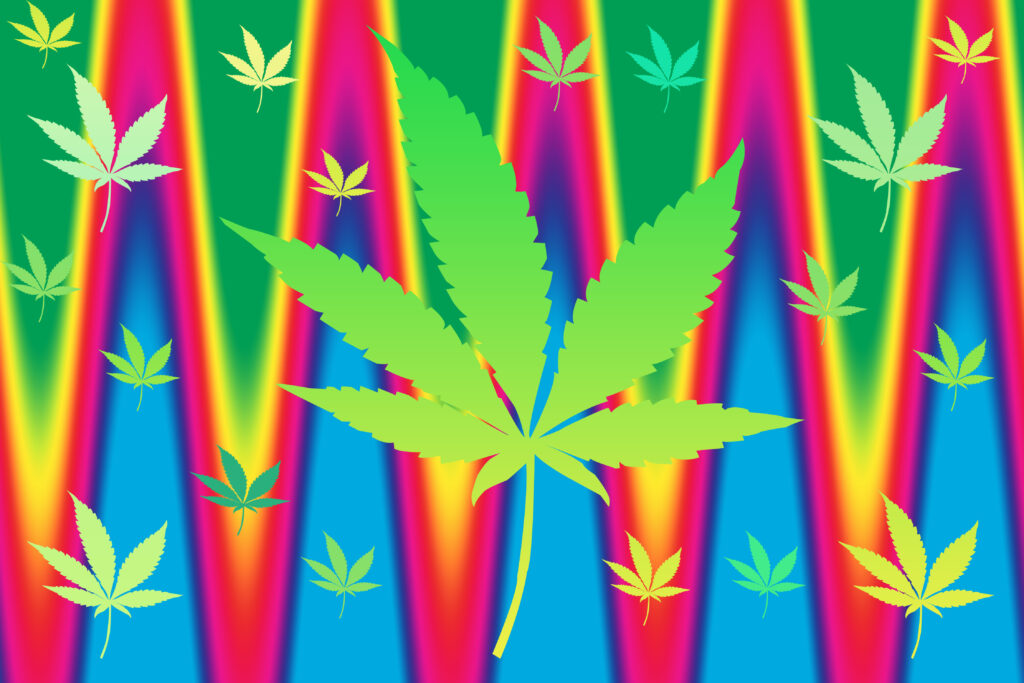
Is THCP Safe?
There hasn’t been enough research on this compound to confirm it’s safe to use. However, there hasn’t been any evidence to suggest otherwise either.
THCP appears to have the same effects on the body as THC — just with more potency. From early reports, it seems THCP shares the same safety level when used at a safe dose. Because of how potent this stuff is, it’s much easier to take too much and experience side effects than it is with THC.
There are synthetic THC analogs that have long tails like THCP that are known to produce more harmful side effects than THC itself. It’s possible that the longer tail on THCP along with a higher binding affinity for CB1 receptors could make this cannabinoid much more likely to produce negative side effects.
The strongest CB1 agonists, such as synthetic cannabinoids, have been shown to produce dependency through this receptor — leading to issues with addiction and withdrawal.
While it’s unclear where THCP sits in terms of safety, there has yet to be any clear evidence it’s any more dangerous than THC.
Either way, use this cannabinoid at your own risk.
Side Effects of THCP
The side effects of THCP have not been well studied, and there have not been enough anecdotal reports from people using THCP to determine any clear side effect pattern.
With that said, THCP binds to the same CB1 receptors as delta 9 THC, so it’s very likely it shares the same side effects as THC. These side effects may be even more pronounced due to the stronger binding affinity of this cannabinoid.
Common side effects of THC include:
- Anxiousness
- Paranoia
- Fatigue or Lethargy
- Insomnia
- Dry Mouth
- Red Eyes
- Dizziness
- Nausea or Vomiting
Will I Fail a Drug Test From THCP?
Conventional drug tests aren’t sensitive enough to differentiate between THCP and THC. If you’ve used THCP within the last 14 days, there’s a chance you’re going to register for THC use on urine or blood tests.
Research on THCP is lagging behind, and we still don’t know exactly how long THCP remains in the system.
It’s wise to avoid using any form of THC at least a month prior to a drug test.
Best THCP Products For 2021
There are very few suppliers of THCP at the moment. This cannabinoid is still being explored, and companies are still developing more cost-effective methods of producing it in bulk.
The legality of this cannabinoid is also unclear at the moment. While it’s likely illegal in the US and most of Europe through various analog or NPS (New Psychoactive Substances) acts, the laws aren’t exactly clear.
With that said, there are a few companies selling THCP at the moment — here are some of the most promising products so far:
1. THCP Vape Carts
Just about any cannabinoid can be found in this convenient vape cart format. These carts can be screwed onto an existing vape pen without having to fuss with changing the heating elements, filling up the reservoir tanks, or adjusting the heat settings for each individual cart.
There are currently no THCP vape carts we can explicitly recommend. Most of the companies selling THCP carts at the moment don’t meet our minimum expectations in terms of quality and transparency.
With that said, if you’re looking for THCP carts, keep your eyes on companies such as Binoid, Barely Legal, Area 52, 3Chi, or Delta Effex.
These are some of the larger and more reputable brands in the alternate cannabinoid space. While none of them offer THCP carts yet, we expect to see them popping up in these shops within the next couple of months.
2. THCP Gummies
Gummies are a staple in the cannabinoid space. They offer all the benefits of a tincture, such as long-lasting effects, ease of use, and cost-effectiveness, but in a much tastier, more discrete package.
There are currently no THCP gummies we can recommend. The only products we’ve seen in this category so far are the THCP gummies by Bees Knees CBD.
3. THCP Tinctures
THCP tinctures are the best starting point for people who have never used THCP because it’s easier to take a smaller starting dose than it is with the other common forms of administration. THCP tinctures come with a specific amount of THCP per milliliter of oil. You can either measure the dose using the included dropper or count the number of drops individually.
Roughly 30 drops are equivalent to 1 mL of oil.
The only THCP tinctures we’ve found that look even half-decent so far is the P-30 THCP Tinctures by Spyglass CBD. These tinctures don’t list a specific concentration of THCP on the bottle, but the most recent third-party lab report shows a potency of 1.25 mg/mL.
The recommended dose on the bottle is ⅕ of a dropper — which works out to 0.25 mg of THCP total.
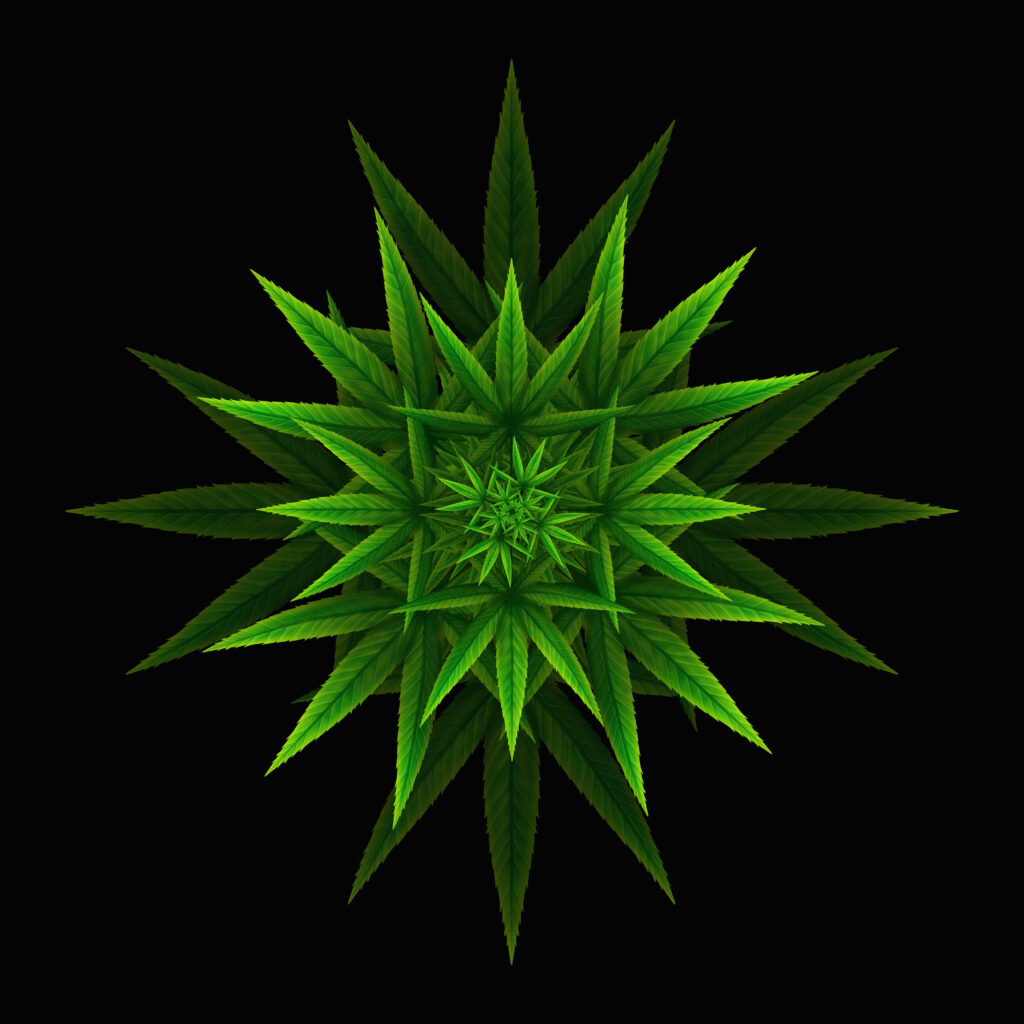
THCP Frequently Asked Questions
There’s still a lot we don’t know about THCP. As researchers continue to test the effects of THCP and more users post their reports online, we’ll continue to update this page on any new findings or insights that present themselves.
Here’s a list of the most common questions and answers regarding this novel cannabinoid.
1. When Was THCP Discovered?
THCP was first discovered on December 30, 2019. It was reported in a research paper by researchers in Italy in an article published in Nature.
At the same time, the group also discovered CBDP — which is a CBD molecule with the same 7-carbon functional group attached.
2. Is THCP Addictive?
There isn’t enough evidence to suggest that THCP is addictive or not — however, there are some experts who believe it could be because of how potently it binds to the CB1 endocannabinoid receptors.
Other compounds have been synthetically created with long carbon tails and a high binding affinity similar to THCP. Some of these chemicals have proven to have some addictive qualities.
It’s likely that THCP could be addictive if abused. Unhealthy relationships with any substance can lead to addiction — especially substances that have strong psychoactive effects.
Consider why you’re using THCP. Has it become a crutch or a means of escaping a reality you find uncomfortable? This is the starting point for any addiction.
Use THCP in moderation (just like anything else), and work on finding ways to cope with pain or other forms of discomfort without the use of psychoactive substances. This will substantially reduce the risk of forming unhealthy addictive relationships with THCP or other substances.
3. Is THCP a Synthetic Cannabinoid?
The answer depends on how you define “synthetic.”
THCP occurs naturally in marijuana plants in very low concentrations. To many people, this makes THCP not a synthetic cannabinoid because it can be extracted from cannabis plants directly.
However, manufacturers would need to process massive quantities of marijuana to get just one bottle of THCP isolate. Instead, most of the THCP currently available is either synthesized from scratch or converted from other cannabinoids. To some, this makes THCP a synthetic product because it’s assembled in a lab from other molecules.
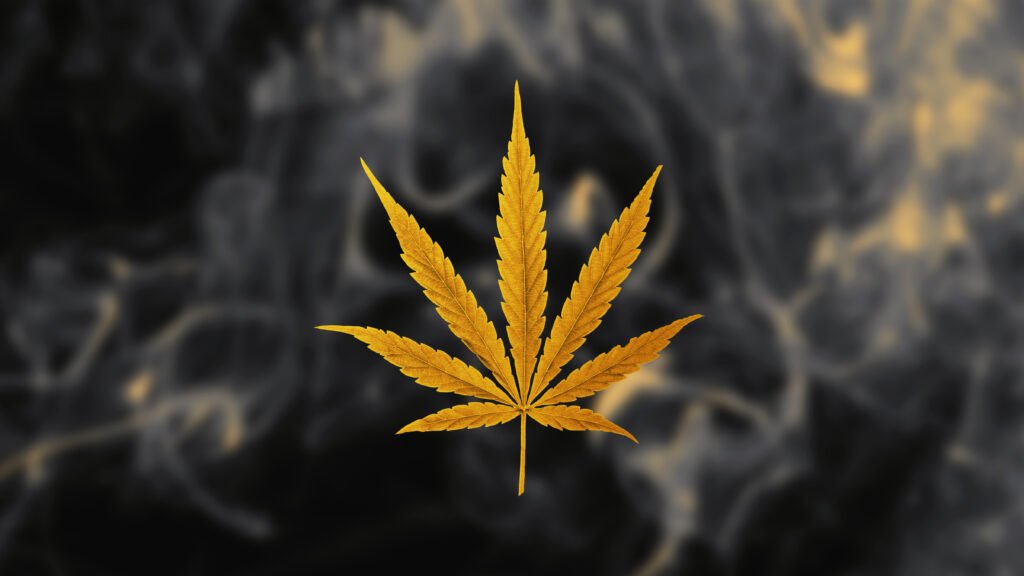
What’s The Future For THCP?
The world of THCP is only just getting started. There’s been so much interest in the alternate cannabinoid space in the last 12 months it’s hard to imagine THCP not becoming more widely available as the market continues to mature.
With a potency range reported to be up to 33 times stronger than delta 9 THC (more like 5 or 10) — this cannabinoid is an easy sell for companies that market psychoactive cannabis extracts.
The real question comes down to how governments will decide to regulate compounds like THCP and THCO. Neither of these compounds is explicitly included on the list of prohibited substances in the United States but are likely included under the Federal Analog Act as illegal by proxy. Delta 8 THC could also fall under this listing, yet the government has taken no clear stance against any of these compounds to date.
In summary, it’s likely we’ll see a dramatic spike in interest for THCP in the next 12 months. Whether the government decides to step in and begin enforcing laws against THC analogs or not will determine how big the public market sector will become.
References
- Citti, C., Linciano, P., Russo, F., Luongo, L., Iannotta, M., Maione, S., … & Cannazza, G. (2019). A novel phytocannabinoid isolated from Cannabis sativa L. with an in vivo cannabimimetic activity higher than Δ 9-tetrahydrocannabinol: Δ 9-Tetrahydrocannabiphorol. Scientific reports, 9(1), 1-13.
